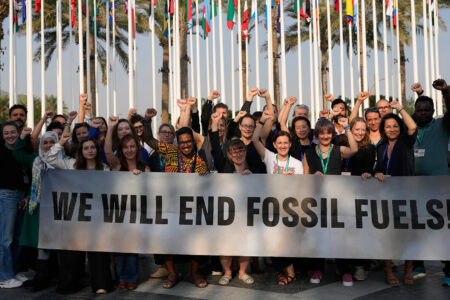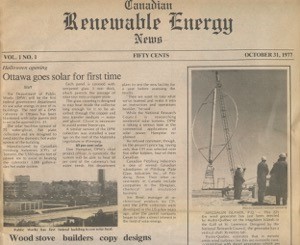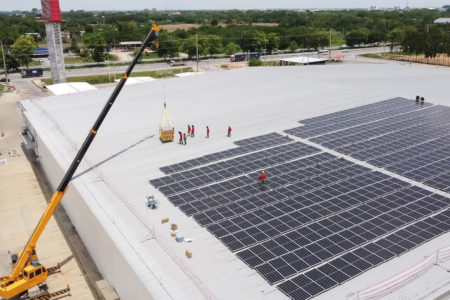
Just over 40 years ago this week, I stumbled across a sheet of paper that reshaped my life and career and should have pointed toward a future without the risk of catastrophic climate change.
On October 31, 1977, vol. 1, no. 1 of Canadian Renewable Energy News hit the stands. The fledgling publication was in search of freelance reporters. For me, this was the start of a three-and-a-half-year assignment as reporter, parliamentary correspondent and finally assistant editor that carried me through roughly half of the paper’s seven-year lifespan. And it was the opportunity of a lifetime to learn about the technologies, processes and mindsets that point toward a postcarbon future.
The first heyday of renewables
CREN covered a cluster of industries that were fiercely innovative and determined, but in need of investment, policy encouragement and ready markets. It was founded by a former Parliament Hill researcher, Doug Nixon, and based in Ottawa. In an era when renewable energy and energy conservation were beginning to flourish but were receiving scant public or mass media attention and precious little political support, CREN brought together the latest news and innovations from across Canada and, soon enough, around the world.

Back then, solar, wind, bioenergy, hydro and energy conservation were all seen as small-time energy options that would never shape national policy or strategy. But CREN reported on the early modelling that showed how a “soft energy path” could completely replace all nonrenewable options by 2025 — and why they should. With the head start North America had 40 years ago, the job should have been all but done by now.
The paper gave voice to a broadly based community of designers and builders, technology developers and business operators, many of them driven by a purpose far bigger than the installations they worked on. They imagined energy systems that were efficient, frugal and safe. Projects that could actually come in on time and on budget. Home energy options that freed low-income households from a choice between fuel and food.
Progress lost
In October 1980, I was part of CREN’s reporting team at the Fifth National Passive Solar Conference in Amherst, Massachusetts. The event was a tableau of an industry on the rise.
The founder of Earth Day, Denis Hayes, was heading the Solar Energy Research Institute; he was the youngest-ever director of a US national laboratory. A national homebuilders’ network had formed to move low-energy construction and retrofit from the margins to the mainstream. Another new national network, Women in Solar Energy (WISE), summed up the politics and technology of the moment in four words: Active Women, Passive Solar. The Franklin County Energy Project’s home insulation campaign was keeping energy dollars in the community, not much concerned with whether the “imported” oil came from Saudi Arabia or Texas.
But a national election was just a couple of weeks away in the US, and Ronald Reagan was poised to tear down all we had built.
A CREN editorial cartoon hangs over my desk to this day and sums up what happened next. It shows Hayes as a rainsuited mariner, confronting a destructive tornado levelling everything in its path. Hayes had assured supporters that renewables could weather the storm. Within weeks, he’d been dismissed.
Reagan’s first budget decimated investment in renewables and energy conservation spending. The big money on Reagan’s “level playing field” for energy went to synthetic fuel subsidies.
About a year later, CREN received an anonymous memo that looked at the subsidies Canadian governments would have to shell out to get industry on board for one of the country’s first heavy oil developments. It showed that an equivalent investment in a national home insulation program would save more energy than the fossil fuel megaproject would produce, creating more jobs that were more evenly distributed across the country.
The oil upgrader went ahead anyway, and to this day, Canada and especially Alberta are overly dependent on the boom-and-bust industry that received that initial infusion of government largesse. We’re still one of the world’s biggest per capita energy users, falling short of a carbon reduction target that is itself inadequate to meet the goals of the Paris climate agreement.
The road not taken
In the years after the Reagan cutbacks, renewable energy funding largely dried up. Energy efficiency efforts focused on specific industries or on encouraging consumers to “do their bit” while the fossil fuel industries, in particular, drove up energy use and carbon emissions. Gone was any notion of setting long-term, economy-wide goals and initiating structural changes to achieve them.
Meanwhile, the atmosphere warms while the oceans acidify, and communities from Fort McMurray to Puerto Rico, South Asia to the Horn of Africa face climate-induced crisis.
And yet — solar and wind electricity are now cheaper than coal, solar outpaced all other new electricity installations in 2016, international investors are clamouring for climate accountability and transparency, and even some of the world’s biggest fossil fuel industries are embracing renewables. On the balance of probabilities, the transition still has just enough time to outrun climate disaster on a global scale.
So this week I’ll take a few minutes to think back to a small but mighty newspaper that presaged a future that should already be here.
Photo: Shutterstock, by Eviart.
Do you have something to say about the article you just read? Be part of the Policy Options discussion, and send in your own submission. Here is a link on how to do it. | Souhaitez-vous réagir à cet article ? Joignez-vous aux débats d’Options politiques et soumettez-nous votre texte en suivant ces directives.






